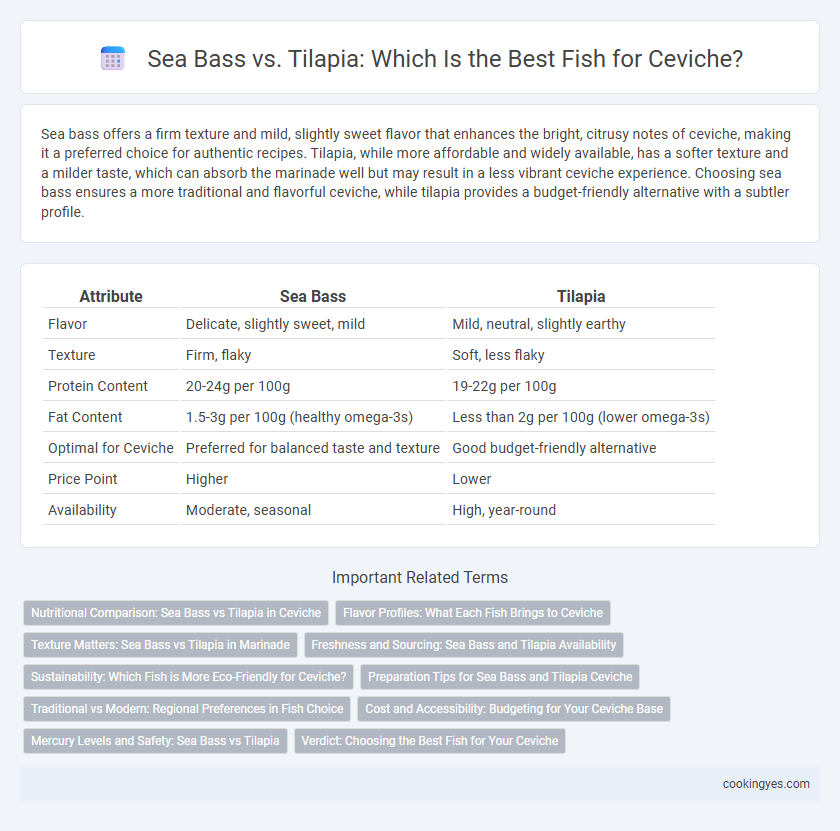Sea bass offers a firm texture and mild, slightly sweet flavor that enhances the bright, citrusy notes of ceviche, making it a preferred choice for authentic recipes. Tilapia, while more affordable and widely available, has a softer texture and a milder taste, which can absorb the marinade well but may result in a less vibrant ceviche experience. Choosing sea bass ensures a more traditional and flavorful ceviche, while tilapia provides a budget-friendly alternative with a subtler profile.
Table of Comparison
| Attribute | Sea Bass | Tilapia |
|---|---|---|
| Flavor | Delicate, slightly sweet, mild | Mild, neutral, slightly earthy |
| Texture | Firm, flaky | Soft, less flaky |
| Protein Content | 20-24g per 100g | 19-22g per 100g |
| Fat Content | 1.5-3g per 100g (healthy omega-3s) | Less than 2g per 100g (lower omega-3s) |
| Optimal for Ceviche | Preferred for balanced taste and texture | Good budget-friendly alternative |
| Price Point | Higher | Lower |
| Availability | Moderate, seasonal | High, year-round |
Nutritional Comparison: Sea Bass vs Tilapia in Ceviche
Sea bass offers higher omega-3 fatty acids and vitamin D content compared to tilapia, making it a more nutrient-dense choice for ceviche. Tilapia provides a lean protein source with lower calories and fat, suitable for calorie-conscious diets. Both fish are rich in protein, but sea bass delivers superior heart-healthy fats and micronutrients essential for balanced nutrition.
Flavor Profiles: What Each Fish Brings to Ceviche
Sea bass offers a delicate, buttery flavor with firm, flaky flesh that absorbs citrus marinade well, enhancing the bright, tangy notes typical of ceviche. Tilapia has a mild, slightly sweet taste with a softer texture, providing a neutral canvas that complements the acidity and spiciness without overpowering other ingredients. Choosing sea bass results in a richer, more complex flavor profile, while tilapia yields a lighter, more subtle ceviche experience.
Texture Matters: Sea Bass vs Tilapia in Marinade
Sea bass offers a firm, flaky texture that holds up well in ceviche marinade, maintaining a tender yet resilient bite that enhances the dish's overall mouthfeel. Tilapia has a softer, more delicate flesh that absorbs citrus flavors quickly but risks becoming mushy if marinated too long. Choosing sea bass over tilapia ensures a balanced texture that complements the acidity without compromising structural integrity in ceviche.
Freshness and Sourcing: Sea Bass and Tilapia Availability
Sea bass, often sourced fresh from coastal waters, offers a firm texture and delicate flavor ideal for ceviche, making its availability more seasonal and region-specific. Tilapia is widely farmed, providing consistent freshness and year-round availability, though its milder flavor may require additional citrus or spice for a balanced ceviche. Freshness is critical for both fish types, with local sourcing and proper handling significantly impacting the final ceviche quality.
Sustainability: Which Fish is More Eco-Friendly for Ceviche?
Sea bass is generally considered more sustainable than tilapia for ceviche due to responsible wild-caught practices and lower environmental impact in certified fisheries. Tilapia farming often involves high water usage and can contribute to habitat degradation if not managed properly. Choosing eco-certified sea bass supports biodiversity and reduces ecological footprint in ceviche preparation.
Preparation Tips for Sea Bass and Tilapia Ceviche
Sea bass offers a firm texture and delicate flavor ideal for ceviche, requiring precise slicing and marinating times to avoid over-curing, typically around 15-20 minutes in fresh citrus juice. Tilapia's milder taste and softer flesh benefit from shorter marination, about 10-15 minutes, to maintain its structure and prevent mushiness. Both fish should be thoroughly rinsed and patted dry before use, and always sourced fresh to ensure safety and optimal taste in ceviche preparation.
Traditional vs Modern: Regional Preferences in Fish Choice
Sea bass is traditionally favored in ceviche across coastal regions of Peru and Ecuador due to its firm texture and subtle flavor, which absorb citrus marinades effectively. Tilapia, a freshwater fish, has gained popularity in modern ceviche recipes in North America and other non-coastal areas, valued for its affordability and mild taste. Regional preferences shape the choice between sea bass and tilapia, reflecting cultural heritage in traditional ceviche and accessibility considerations in contemporary adaptations.
Cost and Accessibility: Budgeting for Your Ceviche Base
Sea bass offers a premium flavor and texture for ceviche but comes at a higher cost and may be less accessible in many markets, often priced above $20 per pound. Tilapia serves as a budget-friendly alternative, typically available for under $10 per pound, making it ideal for larger batches without compromising availability. Choosing tilapia can lower overall ceviche costs while ensuring fresh fish remains easy to source year-round.
Mercury Levels and Safety: Sea Bass vs Tilapia
Sea bass generally contains higher mercury levels compared to tilapia, making tilapia a safer option for ceviche, especially for pregnant women and children. Tilapia's lower mercury content reduces health risks while still providing a mild flavor and firm texture ideal for ceviche preparation. Choosing tilapia for ceviche enhances food safety without compromising taste or quality.
Verdict: Choosing the Best Fish for Your Ceviche
Sea bass offers a firm texture and delicate flavor that holds up well to the citrus marinade, making it an ideal choice for ceviche. Tilapia's mild taste and softer flesh absorb flavors quickly but may become mushy if marinated too long. For the best ceviche, sea bass provides a superior balance of texture and flavor, elevating the dish's authenticity and freshness.
Sea bass vs tilapia for ceviche base Infographic

 cookingyes.com
cookingyes.com